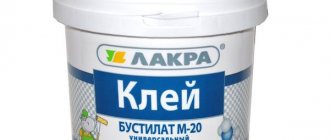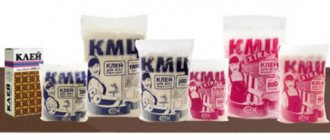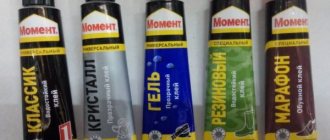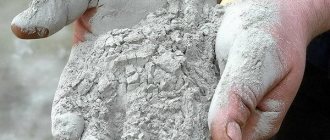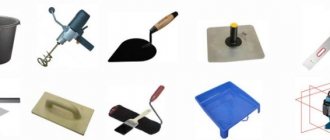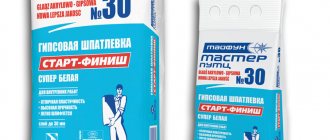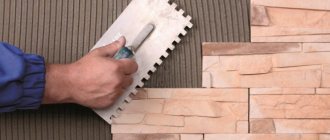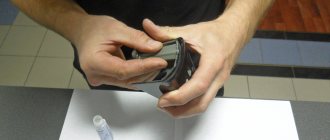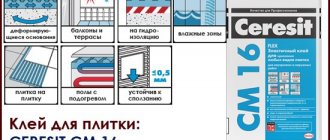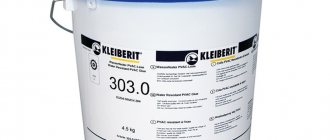PVA glue is a universal composition that has become very popular for use both in office supplies for gluing various objects, and when performing various finishing works to strengthen primers, dilute wallpaper glue and putties.
First you need to understand what PVA glue is. This is a liquid substance of polyvinyl acetate (vinyl acetate polymer) in solution with water, the addition of plasticizers and special components, which forms a familiar adhesive solution for gluing many materials.
To find out how long PVA glue takes to dry, you need to, first, remember that this composition has a large number of varieties that behave completely differently when working.
The time it takes for the substance to dry is influenced by a number of factors, from the type of surface to the air temperature in the room. This process can take from a few minutes to a whole day. To achieve the desired result quickly, you should carefully prepare for the gluing process. Let's look into all the intricacies.
Main characteristics
PVA glue is a special thick mixture that has a characteristic odor reminiscent of a type of alcohol. In essence, it is a dispersion of PVAD, plasticizers and a number of other additives. It is safe to say that this composition is completely harmless to human skin.
Of course, there are brands of glue that contain auxiliary ingredients, and they cannot be called completely safe. In most cases, these are specific solutions that have a specific purpose for special types of activities. As a rule, most manufacturers produce ordinary PVA glue, the so-called “universal” one, which does not contain potentially dangerous components.
What is glue made from?
Understanding production technology is not difficult if you have the necessary equipment. A completely different question is the chemical composition of PVA glue.
The following components are used for manufacturing:
- binding raw materials;
- thickener;
- adhesive dispersion;
- preservative;
- coalescent
At first, this list is surprising, but it’s enough to remember what was taught in chemistry lessons, and everything will become quite logical. When purchasing materials separately, their cost does not seem high, but when all these components are combined, the amount comes out to be considerable. Fortunately, sales of glue bring in many times more profit and all expenses are easily covered.
What types of PVA glue are there?
As mentioned above, this mixture can be used to connect almost all surfaces. It is used both by schoolchildren when performing office work, and by builders for gluing wallpaper, joining parts, priming, etc.
Let's take a closer look at each individual type of PVA:
- “Household” - it is used in cases where it is necessary to glue non-woven wallpaper, paper or vinyl based. This adhesive is also used for wooden and concrete bases that have been previously plastered.
- “PVA super (M)” - it can be used not only in the domestic sphere from vapor-permeable materials. With its help you can paste not only wallpaper, but for example linoleum. The yellowish super product does not contain any foreign additives, and its frost resistance lasts about 6 cycles at a temperature of -40 °C.
- “Universal” - it can be used for gluing combined surfaces. It is ideal for gluing linoleum, carpet, serpyanka, cardboard, metal, glass. The product can also be used for gluing laminated paper decorative plastic to chipboard, fiberboard, and MDF materials.
- “Construction” - it includes different types of mixtures that are used in construction. So, for example, if the composition is carpentry, then it is most effectively used for wooden surfaces. There is also parquet glue that is specially designed for it.
- “Stationery” - it is actively used for joining paper, photographic paper, and cardboard. It is most often purchased by schoolchildren, for example, if they need to glue puzzles into a picture. The downside of this substance is its low resistance to low temperatures and moisture.
- “Extra E” - used to work with materials made from vapor-permeable raw materials that do not require special technology for operation and future operation. For example, with plywood, fiberboard, cardboard, wood, paper, and also added to plaster, putty mixtures, etc.
- “PVA dispersion” - used as an additional ingredient in construction mixtures, which are used in many industries, in the shoe industry, for the repair of furniture, in water-dispersed paints, printing, for gluing paper and in the production of cardboard packaging, as well as carpentry work .
If the solution has expired, this is not a problem. Just shake the jar a few times and you can start using it, but there will be a loss in quality.
How and why to dilute
Polyvinyl acetate glue is often diluted with water. It is not recommended to add water to universal, second and Moment glue, as they will lose their adhesive function. It is also not recommended to dilute dispersion grades. You can dilute household and office glue. This allows you to reduce material consumption or restore its consistency if the glue thickens during storage.
Wallpaper glue is sold dry. Before use, the glue is dissolved in warm water at the rate of 100 grams of dry product per 1 liter of liquid. The solution turns out like thick sour cream so that the brush or roller gets stuck a little in the solution. To obtain a primer, the proportions are slightly changed, increasing the proportion of water.
Office glue is also used as a primer. To dilute it, you will need warm water and adhesive material in a ratio of 2 to 1. The result is a light white liquid product.
Tip: Heavily diluted glue creates a less strong and, therefore, less durable seam.
PVA glue is one of the most versatile compositions; it is used both independently and in combination with additives and modifiers that impart additional beneficial properties. It is still one of the safest adhesive materials available. Use it wisely and the result will meet all your expectations.
- Description
- Buy with this product (1)
Description: PVA glue for wood.
- used for gluing all types of wood products
- used for working with wood, chipboard, fiberboard, MDF
- has high adhesive ability
- non-toxic
- Glue is resistant to bacteria
- glues veneer perfectly
What affects the drying time of PVA glue?
The drying time of the product is influenced by many factors. Regardless of the fact that the manufacturer indicates on the container with the composition the approximate drying time of PVA glue. All these indicators are relative.
Also on the packaging you can find detailed information under what conditions the final hardening of the glue takes place. For example, this can happen at a temperature of 20-24 ° C, with air humidity not exceeding 60%. Accordingly, it is rarely possible to achieve similar ratios at home. Therefore, the specified 24 hours will not be enough to completely dry the product.
Factors influencing drying:
- Temperature. If the room is warm, the glue will begin to harden faster. At low temperatures, on the contrary, the drying time will increase. In this case, the adhesive properties and adhesion quality will deteriorate.
- Area of surfaces required for gluing. The larger it is, the longer the drying process will take.
- Mechanical impact. If you exert increased pressure and press the bases tightly together, the hardening time will be shortened.
- Cleanliness of the base. If the base of the objects being glued is cleared of grease, dirt and dust, the product will dry much faster.
- Thickness of the applied layer. If it is thin, the mixture will dry much faster. However, some surfaces, such as porous wood, will require a thicker layer of glue, as the product will be absorbed into them abundantly.
- Texture. If the surface of the base is flat and smooth, it will take a long time to dry. The porous surface absorbs moisture well, which will result in the PVA glue drying faster.
- The product contains 95% polyvinyl acetate, and the remaining 5% are special additives that help improve the quality of the product. Depending on the type of glue chosen, this ratio may vary, which also affects the drying time.
- Type of mixture. If the glue composition is marked “Super” and “Moment”, then it will dry in a matter of seconds. One of the disadvantages of the product is that there simply will not be time to correct the position of the parts being glued together.
Product quality. The original PVA solution will dry as quickly as possible than the craft. Therefore, purchase this mixture only exclusively in specialized construction stores.
How long does PVA glue dry on threads - maximum and minimum time
To find out the exact drying time of PVA glue, you must immediately note that this product has many varieties that behave in a variety of ways.
First you need to understand what PVA glue is . This is an emulsion of polyvinyl acetate with water, a plasticizer and additional additives, which has a characteristic odor and is used for gluing materials.
There are several main types of PVA glue:
- Domestic. Used for gluing paper products.
- Stationery ( PVA-K ). Used for gluing paper or cardboard. Susceptible to water and low temperatures.
- Universal ( PVA-MB ). Suitable for wood, paper, fabric, etc. Frost-resistant.
- PVA-M is a universal adhesive that provides gluing of fabric, wood, cardboard and paper.
is suitable for gluing threads and crafts . In order for the product that has been glued to dry completely, at least 24 hours . Waiting for 24 hours is guaranteed to ensure complete drying of the glue. Depending on the conditions of the material, the glue may dry faster or slower.
Factors affecting drying speed
There are many factors. Which affect the drying speed, here are the main ones:
- Temperature. This parameter greatly influences the drying time. The lower the temperature, the longer the process will take.
- Area of glued surfaces. The larger it is, the longer you will have to wait.
- Load on joints. It's no secret that when you physically impact the joints, the glue between them dries faster. However, not all products have the ability to provide such an effect.
- Composition of the adhesive substance. Different brands have different chemical structures. Which also affects the drying speed. In order to find out the composition and the exact rate of hardening, you should use the instructions. It is usually located on the back of the package.
- Clean surfaces. The presence of dust or greasy areas may increase the drying time of the material.
This is a list of the main factors that affect the speed at which glue hardens on different surfaces. However, there is an opportunity to speed up this process.
When working with glue, you should follow safety precautions, as the glue can harm your health if it gets into your eyes.
Recommendations for applying glue
Working with PVA is not difficult at all. The instructions clearly indicate that you can glue a certain type of composition and how to use it correctly. But, as with any other work, the surface must be prepared and carefully processed. It must be clean and dry, so it is cleaned of dirt and dust.
For example, if you plan to apply the product to smooth, even walls, then they are treated with fine-grained sandpaper, this will improve the quality of adhesion. And if you will be gluing wallpaper on a rough base, then it should be thoroughly primed in advance. You can find out how long it takes for the primer to dry from our review.
It is important, regardless of the type of paste, to follow simple recommendations:
- The product is applied to the coating that will gradually (slowly) absorb it, that is, less loose.
- To treat thin wallpaper, applying one layer of solution is enough, and for thick coatings you will need two.
- If the composition needs to be applied pointwise, use a specially designed nozzle. If it is not available, you can use improvised items, such as a syringe without an attachment needle or a regular pipette.
- If the coating has a large area, then for application you can use a good lint-free roller, a brush, or, in extreme cases, a sponge. You need to coat it starting from the middle and slowly moving towards the edges.
- To remove air bubbles, you need to place a clean sheet of paper on the coating and carefully smooth out the resulting irregularities through it with a rubber roller or just your palm.
- If possible, it is advisable to place the glued products under a press to ensure greater reliability.
Important! For gluing paper products, it is recommended to purchase the so-called “archival” PVA composition. It does not contain acids, and the paper will not show yellowness after a couple of years.
Production technology
Enterprising people who know what PVA glue is can easily make money from its production. This is not surprising, because the technology for producing the composition is not that complicated.
The adhesive production process includes the following stages:
- Preparation of raw materials.
- Crushing components.
- Selecting the required portions and determining the weight of the raw materials.
- Processing of ingredients.
- Cooking the substance.
- Infusion of the remedy.
- Distributing the glue into portions and placing it in packaging.
Special equipment is necessarily used in production: a mortar mixer, a dissolver, a filling machine, etc. Manually, as a rule, only the placement of raw materials into the required tank occurs.
When creating glue in factories, beginning manufacturers often have problems due to the properties of this composition. The fact is that PVA has a high viscosity, which complicates the procedure for kneading, dispersing and delivering it to the packaging site.
GOST PVA glue
It is important for every buyer to know the state standard of adhesive mass so as not to waste money on a product that does not meet the quality and, accordingly, is not able to perform all its functions.
The number of PVA glue according to GOST is 18992-97 or 18992-80.
PVA glue, properties after drying
One of the signs of an adhesive composition according to the rules is its dry state. After drying, the properties are preserved, the glue forms a transparent viscous film. It can be easily seen visually. It is through this film that the materials are held together. There is no definite answer to how long PVA takes to dry. On average about a day.
The probable answer is in the instructions. It depends on the area of application, the area of smearing, the temperature of the room and the use of a hair dryer, the number of layers and the properties of the material.
Container and packaging
Today, on store shelves you can easily find PVA glue in jars, buckets, and tubes. All these containers are made only of plastic. Spouts are provided only on tubes, so when using adhesive in a bucket or jar, you additionally need to purchase a device for conveniently distributing the mixture over the surface.
As for packaging, the maximum volume of PVA glue is 10 kg. This quantity of the composition is sold in buckets. Smaller volumes – 5 kg, 2.5 kg, 1 kg, 250 g, 100 g, 70 g, 50 g.
Glue consumption
One of the important characteristics, which is also an advantage of the product, is the volume of its use per standard area. Thus, the consumption of PVA glue per 1 m² ranges from 100 to 500 g. Here everything depends on the weight of the materials being joined, as well as the characteristics of their surface.
Best before date
The glue can be stored for 12 months. But the manufacturer makes some of its varieties, for example, building composition, more durable and doubles this period of time - up to 24 months.
After the expiration date, PVA glue acquires an unpleasant and strong odor, so even if you forget about the expiration date, it will not be difficult to distinguish an unusable product.
Drying time for PVA glue
Drying process on paper
Surely everyone has wondered how to glue paper to paper? So this mixture is used extremely often by those who planned to glue paper products. The mixture dries in approximately 10-15 minutes, sometimes within half an hour. Apply glue to the paper surface in a small and even amount. Otherwise, it will make the paper wavy and slow drying.
How long does it take for PVA glue to dry on wood?
When gluing a wooden surface, PVA glue dries within 24 hours. However, the mixture will acquire its properties 7 days after application. It will become as monolithic as possible and resistant to moisture.
Be sure to press down on the bases to be glued, otherwise the wood will simply absorb all the moisture, begin to swell, and the result of gluing will be negative. If you need to seal a small crack, the mixture should be mixed with sawdust. In this case, the drying time will be from two to three hours.
Drying on fabric
It is not uncommon to hear the question of what is better and how to glue fabric to fabric? We can immediately say that with such work the mixture takes a long time to dry, about 6 hours. This is due to the fact that the fabric absorbs moisture. When gluing, the bases should be pressed against each other for several hours.
PVA construction adhesive: an ideal product for construction sites and renovations
PVA construction glue is one of those few things for which it is difficult to find a replacement - both on a construction site and during repairs. It improves the physical and chemical characteristics of cement mortars and gives them greater viscosity. Plaster, putty, tile and various primer compositions, grouts, and self-leveling floors prepared with PVA glue become more plastic. Added to dry mixtures, construction PVA acts as a modifier, improving their technological properties and enhancing adhesion to various surfaces. PVA construction adhesive successfully glues plastic to wood fiber, particle boards, MDF, and ensures good adhesion of tiles and ceramic tiles to the surface. Attention: the builders forum warns that when laying tiles it is very important to correctly select the thickness of the PVA glue layer applied to both surfaces. And also pay special attention to the duration of the pre-contact exposure.
Construction PVA (for example, virtuoso) glues both wood-based boards and natural wood (products), leather, foam rubber, porcelain, glass. PVA construction adhesive can also be used for linoleum, paper, vinyl, fiberglass wallpaper, textile fiber materials, gluing paper or cardboard.
Universal wood glue
Universal wood glue is a plasticized PVA dispersion (base) with special additives. Carpentry glue (or for wood) and white classic stationery glue PVA (for example, Euro) are similar in appearance, but there are subtle differences between them. The former takes longer to dry, is more resistant to humidity and environmental influences, has a stronger adhesive force, but also has a shorter shelf life. And if the label of PVA wood glue is marked “Frost-resistant formulation,” then it can withstand at least 5 freeze/thaw cycles. It can also be briefly frozen to a temperature of minus 30 degrees without losing its properties after defrosting.
Universal carpentry adhesive is indispensable when performing critical work that requires high strength; in the furniture industry, it is unthinkable to manufacture furniture without it. It firmly bonds wood and wooden structures, not to mention plain and laminated paper, cardboard, leather or fabrics. Environmentally friendly modified PVA construction adhesive for wood contains polymerization accelerators, fillers, thickeners, hardeners and other additives. PVA construction adhesive has excellent adhesion to wood and the base, and after drying it forms very strong, completely transparent elastic seams. The minimum permissible temperature for work is +5 degrees, however, high weld strength can only be achieved at temperatures exceeding +10 degrees. If the adhesive seam will be subjected to significant loads, the bonded surfaces should be fixed and kept in this position for 24 hours.
Universal PVA glue - the most popular product based on polyvinyl acetate - has increased adhesion and even greater adhesive strength than construction PVA. In construction, universal PVA adhesive can be used as a universal primer, plasticizing additive in concrete, chalk, cement plaster and tile mortars. In the domestic sphere, the station wagon is used for gluing cardboard, plywood, paper, wood, gluing vinyl wallpaper, and photographs. But for gluing furniture if the adhesive seam will experience increased stress, universal PVA glue is not recommended. The station wagon is also not suitable for products exposed to moisture, i.e. it is intended only for interior work.
Bolars PVA
A prominent representative of this line is PVA bolars - a classic universal adhesive that the manufacturer produces for indoor use. They can be used to glue pile-based linoleum, glue paper, wallpaper, durable cardboard and fabrics, as well as wooden products. Bolars PVA can be applied to surfaces made of concrete, brick, plastered wood, and can withstand 5 freezing cycles in storage. Prorab PVA glue, which has the same application, has similar properties.
Frost-resistant super glue PVA is considered to be of the highest quality - it has a thick consistency and contains a large number of additives. In addition to paper and cardboard, it glues metal and wood, facing tiles, plastic, ceramics, leather, fabrics, and fixes linoleum and similar coatings. If you need to repair furniture or if important carpentry work requires particularly strong gluing of wood, it is recommended to buy PVA Novgorod super glue. Reinforced PVA glue “Extra” (Moscow) is also suitable for these purposes, forming an elastic, transparent, durable film after drying.
PVA aqueous adhesive base
A concentrated polyvinyl acetate base product with the strongest adhesive power, the basis of all water-based PVA adhesives is a PVA homopolymer dispersion. It has good binding properties, high adhesion to various materials, and a low price. It is widely in demand and used in many industries, and it is industrial enterprises that most often sell this product wholesale.
How to significantly speed up the drying process?
PVA glue, according to the manufacturer's instructions, dries naturally in about 24 hours. But sometimes a logical question arises: how to quickly dry a fake made on its basis. To do this, place the item in a warm and dry place. For example, in winter you can place the product near the radiator.
You will also need to use the following simple and tricky methods:
- Press the bases of the objects to be glued tightly together. To do this, you can use books, as well as the leg of a table or chair.
- Use heat. You can influence the mixture using a hairdryer or a heated lamp. The temperature during this process should not exceed 100 °C.
- The composition must be applied evenly over the entire surface area.
- The parts to be glued must be thoroughly cleaned and degreased (white alcohol, acetone, etc. will do). This will help speed up the gluing process.
Today on the market there are many brands from different manufacturers, which contain completely different components, which also significantly affects the drying period. Therefore, before purchasing, it is recommended that you pay attention to the instructions in the instructions that come with the kit inside the package or are located on the back of the bottle.
Factors affecting drying time
Initially, PVA glue was used for gluing walls with heavy wallpaper, but over time it gained great popularity. Touching upon the topic of drying, it is necessary to note the influence of various factors on this process:
- Temperature - the glue dries quickly in a warm room; in cold weather, the time increases by 3-4 times. Therefore, it is recommended to keep the product warm or use a hair dryer to get the desired effect.
- The area of the glued surface - a small product dries faster than a large one.
- Compression force - everyone who often uses PVA knows that the stronger you press the surfaces to be glued together, the shorter the setting time will be, and the strength will increase.
- Cleanliness of surfaces - if they are not first cleaned of grease and dust, the drying speed and reliability will decrease significantly.
- Surface texture - loose, porous, non-moisture resistant material easily absorbs the adhesive base and significantly reduces drying. The moisture-resistant smooth surface can dry within 24 hours.
- The amount of layer applied - the smaller the layer, the faster it dries.
With the advent of specialized additives, the scope of application of PVA has increased significantly. Therefore, when deciding on a job, you need to carefully read the scope of application of the adhesive composition.
Comparison of PVA and bustylate
Bustilate and PVA, what is the difference? In conclusion, it is worth answering one more popular question. They are often asked by neophytes because they mistakenly consider these compositions to be completely identical. But in reality there is a difference between them, although not very significant, because their basic functions and properties are still similar.
First of all, it is worth noting that PVA is glue in its pure form, and bustilate is the same PVA, but with the addition of various impurities. Just due to the additional components in the composition, the second has two main advantages over the first:
- The shelf life of bustilate is twice as long as that of PVA.
- Bustilate has higher adhesion.
At the same time, for children's crafts and repairs in rooms where children are present for a long time, it is recommended to use PVA. And the reason for this is its environmental friendliness compared to bustylate.
In terms of resistance to moisture, heat and frost, both compositions are the same. In addition, the rules for applying and removing them from surfaces are identical.
Bustilat is an old Soviet-developed glue, but PVA is much older, although it is far ahead in popularity. Marketing played a major role. The leader was also given an advantage by the environmental friendliness of polyvinyl acetate. The toxicity based on it is more determined by the properties of solvents and additives.
We are organizing a business for the production of PVA glue. Own business: adhesive production
In this article:
There is probably no person today who has never used PVA glue: even small children use it to glue paper cards and create appliqués, and adults actively use glue in construction and painting.
However, not many people know that glue production was first organized in 1912
entrepreneur
Farben
. At that time, Farben was working with adhesives that formed films.
And the technology for making the most popular glue was invented by two independent scientists - Lee Seung Gi and Fritz Klatt. The German doctor Fritz Klatt discovered the production of PVA glue by extracting it from acetylene gas. As a result of polymerization, the gas formed a solid with adhesive properties.
A few years later, Korean scientist Lee Seung Gi
discovered a fiber that later came to be called
vinalon
. Already in 1941, this material was patented, and later they began to use vinalon as a raw material component for the production of PVA glue.
Types of PVA glue and their features
Today, the commercial production of adhesives is very developed, and leading enterprises produce the following types of PVA glue:
- Household PVA
- this type of adhesive is used for gluing wallpaper on plaster and wooden surfaces, as well as for joining paper. Its features are high frost resistance. - PVA stationery
- this type of glue is familiar to everyone. It is used for gluing paper, cardboard or photo paper. Stationery glue is widely used in printing. This adhesive is the safest for children; it dissolves easily in water. - PVA is universal
- this substance allows you to glue products made of porcelain, wood, and various types of fabrics. Its frost resistance is six cycles of freezing and thawing. - Super PVA
is a high-quality adhesive that provides reliable bonding of porcelain, metal, plastic, leather, tiles and other materials. This glue has a thick consistency and contains many additives. - Homopolymer polyvinyl acetate dispersion
is the most strongly adhesive PVA adhesive. It contains plasticizers. This type of glue is widely used in industrial enterprises; it belongs to the third toxicity group.
Raw materials for making PVA glue
The composition of raw materials in different types of PVA glue is different. However, all raw materials used in glue manufacturing enterprises can be divided into the following groups:
- Adhesives
- starch, vegetable or synthetic resins, dextrin, nitrocellulose. These substances provide the cohesive, adhesive strength of the adhesive joint. - Solvents
- acetone, gasoline or esters. Solvents have a huge impact on the formation of the physical and mechanical properties of the glue, namely heat and water resistance and the amount of shrinkage stress. However, solvents reduce the strength and tightness of the adhesive layer. Therefore, the composition of solvents in the glue should be minimal. - Plasticizers
– glycerin, low volatile liquids, camphor oil. Plasticizers are included in the adhesive to enhance the ductility and flexibility of the adhesive film. - Fillers
– chalk, talc and kaolin. Thanks to fillers, the strength and heat resistance of the adhesive improves. - Hardeners
- promote rapid curing of the glue. Porcelain, metal, and glass are used as hardeners. - Stabilizers and inhibitors
are included in the adhesive to increase the shelf life of raw materials. Aromatic amines, styrene inhibitors, and some nitro compounds are used as inhibitors.
Regulatory documents regulating the quality of adhesives
Beginning entrepreneurs interested in the features of PVA glue production should also familiarize themselves with the list of regulatory documents that regulate the quality of the finished product.
These main regulatory documents include:
- GOST 28780-90 – Polymer adhesives. Terms and Definitions;
- GOST 30535-97 – Nomenclature of indicators;
- GOST 26454-85 – Method for determining the optimal elasticity of adhesive;
- GOST 18992-80 – Polyvinyl acetate homopolymer coarse dispersion. Technical specifications;
Regulatory documents that regulate the requirements for production premises include:
SNiP 2.09.02 – requirements for main production buildings and premises;
PHOTO GLUE
The simplest and most popular is a glue stick with a mark for the photo (it says solvent free, acid-free and non-toxic on the tube). It is better to choose glue from these brands - UHU photo stic, Erich Krause, Collage Glue Stick from Ranger, Tacky Glue Original from Aleene's. This glue needs to be applied in a thin layer; if there is too much, the paper may sag. When buying a glue stick, be sure to look at the expiration date and do not buy it at street kiosks; temperature changes greatly affect the quality of the glue.
Liquid glue Acid-free Tacky Glue - does not turn yellow, suitable for photographs, consistency similar to PVA. The glue jar has a thin spout and the glue is squeezed out economically. When it runs out, you should hold the jar with the spout down so as not to wait or make extra effort to squeeze it out.
Photo corners are suitable for those who make custom albums. Sold in rolls or in sets on sheets. They come in a variety of colors including transparent and patterned. I don't use them, so I can't speak about durability. I assume that the properties of photo corner glue are similar to double-sided tape, but as you know, it is not durable.
DIY PVA
As you can see, the glue has good performance parameters, which, coupled with its affordable price, has made it the most common model. Moreover, it can be prepared at home. Many people are interested in the question of how to make PVA glue? You can read about this on almost any website with home tips:
1. First, you have to go shopping to purchase everything you need. We will need the following list of ingredients:
- distilled water (one liter);
- photographic gelatin (one five-gram package);
- glycerin (four grams);
- wheat flour of the highest or first grade (100 grams);
- ethyl alcohol (20 milliliters).
2. When all the ingredients have been purchased, you can start cooking. At the first stage, gelatin is soaked in water and the mixture is left to infuse for 24 hours. No special conditions are needed, but it is worth taking a metal container for this purpose that has no food use.
3. After a day, you can begin direct gluing. Place the container with gelatin in a water bath and, stirring constantly, add all the components purchased in advance, except alcohol and glycerin.
4. You need to cook the mixture until the consistency is a sour cream-like substance. By the way, it will also be similar in color to this dairy product.
5. Then you should remove the container from the heat and add the missing components to it
It is very important to mix everything thoroughly until a homogeneous mixture is formed without lumps or solid impurities. This may take about 10-15 minutes
In this simple way you can prepare PVA right in your kitchen. If everything is done in compliance with the specified technology, then its properties will not differ from the purchased model. It is also worth preparing in advance for its storage an opaque container with a hermetically sealed lid. Otherwise, you won’t be able to protect your glue, and it will simply harden in the open air.
If a larger amount of a substance is needed, for example, to carry out repairs, then you simply need to proportionally increase the consumption of components by the required number of times. The gelatin infusion time will not change.
How to make PVA glue at home
If they don’t want to spend money on packaging from the store, people try to figure out how to make PVA glue themselves. Of course, there are no particular difficulties in this, but the ingredients will need to be selected exactly:
- 4 g glycerin;
- 1 liter of distilled water;
- 100 g wheat flour;
- 20 ml of ethyl alcohol;
- 5 g gelatin.
The process of cooking the adhesive composition is as follows:
- Soak the gelatin in plain water, as indicated in the instructions on the package, and leave for a day.
- Combine all components, except glycerin and alcohol, in a separate container and place in a water bath until completely melted and transformed into a homogeneous and thick mass. At the same time, do not forget to stir the mixture.
- Add the remaining ingredients to the resulting composition, mix thoroughly and remove from the water bath.
- Wait for the mixture to cool and immediately begin using it or place it in a container and close the lid tightly.
Consumers are also interested in how to make PVA glue colored and whether it is even possible. Oddly enough, such an experiment can be safely carried out without any special skills.
The following ingredients can color the adhesive composition:
- watercolor paints;
- gouache;
- nail polish;
- iodine;
- brilliant green;
- pencil lead;
- marker/felt-tip pen (draw a thicker spot on the paper and drop glue there).
You can choose the quantity of these components yourself, depending on the desired color saturation. Having combined the PVA and the coloring element, the mass must be thoroughly stirred using a wooden spatula or a toothpick, if its volume is minimal.
